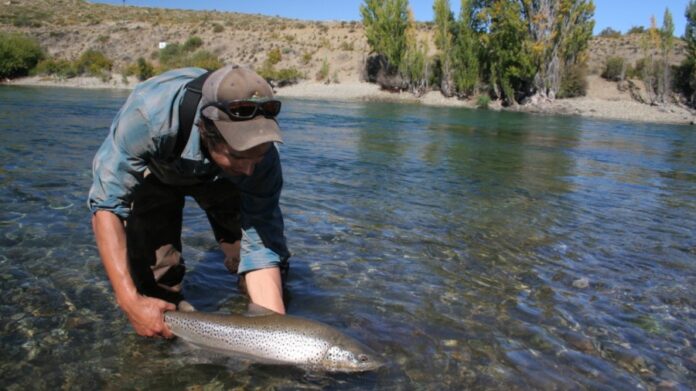All photos by Evan Jones
Patagonia is a surprisingly big place: with a total area of over 250,000 square miles, it’s larger than California and Oregon combined. And just like those states, Patagonia also boasts a huge variety of biomes and fisheries, each with its own unique character and appeal. So if you’re among the growing number of anglers considering taking a trip down there, you’ll want to ensure that your chosen destination is a good match for your expectations and aspirations, because there are a lot of different options.
The Argentine side, which makes up about 90% of Patagonia, can be conveniently broken down into 3 distinct zones: Northern, Central and Southern. This series will highlight the main features, benefits, and potential drawbacks of fishing in each zone so that readers can make more informed decisions about visiting this remote part of the world.

The Northern Zone
The northern zone encompasses everything from the small town of Aluminé, located in Neuquén province at the far northern end of Patagonia, down to the major tourist city of San Carlos de Bariloche in Río Negro province roughly 300 kilometers to the south. The western mountains are covered in dense temperate rainforest here, with large lakes nestled into high valleys collecting huge quantities of rainwater that eventually flows eastward and onto an arid plain vaguely reminiscent of the American West. The freestone rivers run cold and clear, with stony bottoms that support ample insect life and high numbers of trout. This is the Patagonia of legend, the region that celebrity anglers like Joe Brooks made famous so many decades ago on rivers like the Limay, Malleo, and Chimehuín.

Most of the roads are paved in the Northern zone, and there is ample public access thanks to sprawling national parks throughout the mountains, and a generous high-watermark rule along the rivers to the East, which allows anglers to follow the streambed so long as they enter and exit from public easements. There are so many different rivers packed into this area that it’s possible to fish more than one in a single day if you have the desire and the stamina for it. This is also the best region of Patagonia for floating, with many different operators to choose from and myriad places to launch and land. Car rentals are readily available in San Carlos de Bariloche, there are buses that run through the national parks during the summer months, or you could even take a taxi from town. It’s never very far to the nearest river, and there are plenty of campgrounds.

The Northern region is best visited either early or late in the season, ideally between November and December, or between March and April. During the high summer months of January and February, tourists from both Buenos Aires and abroad descend upon this region in surprising numbers, which can make it difficult to find undisturbed waterways that aren’t on private property. In addition to the crowds, summer tends to mean lower, warmer water this far north, which stresses out the larger trout and forces them to take shelter in the depths of the lakes, far out of the reach of fly anglers. Although if you’re planning more than just a fishing trip, the summer months in Northern Patagonia are the best time and place for amenities such as gourmet restaurants, English-speakers, shopping, and other outdoor activities like rock-climbing or kayaking.
Orvis-endorsed options in the Northern region include San Huberto Lodge and Patagonia Nomads. For more information on fishing in Argentina, CLICK HERE, or call Orvis Travel’s Jeremy Kehrein at 1-800-547-4322.
Evan Jones is the assistant editor of the Orvis Fly Fishing blog. He spent two years living in Argentina and writing a popular guidebook on the region, and now makes his home on the Front Range of Colorado.
Credit: Source link































